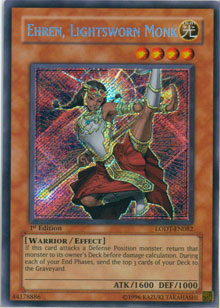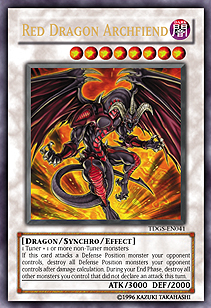The damage step is riddled with "event-specific chains:" chains used to respond to a specific event. They are divided up amongst several points of the damage step, each with its own purpose. It is useful to be familiar with these chains because they will also help you to understand the damage step better.
The Damage Step Chains
The damage step is split up into a sequence of events. Effects activated "during damage calculation" have a chain, effects activated "when battle damage is inflicted" have a chain, the flip effects of flip effect monsters have a chain, and effects that activate when the monster(s) destroyed by battle are sent to the graveyard have a chain. Each chain has a specific purpose, so effects that are applied in each chain tend to be focused on that purpose. Many effects can’t be activated in the damage step at all, which helps to simplify things.
The Start of the Damage Step
Some continuous effects start to get applied at this time, without starting a chain. When Steamroid battles another monster, its ATK increase or decrease begins at this time. When Rampaging Rhynos attacks a monster in its same column, its ATK increase is applied here as well. Continuous effects aren’t the only effects to use this timing.
Trigger effects like Neo-Spacian Grand Mole’s also apply here, although there aren’t very many to speak of. Monsters like Sasuke Samurai and the Mystic Swordsman family also activate their effects at this time, while specifically mentioning that the face-down monster they attacked isn’t flipped face up. You can chain counter trap cards to negate these effects, or any effect that modifies the ATK and/or DEF of a monster . . . although it is usually better to make sure you know what you are attacking first.
Face-Down Monster Is Flipped Face Up
 When a face-down monster is attacked, any continuous effects it has are applied immediately. Flip effects or trigger effects the monster has aren’t activated until after damage calculation, unless the monster’s effect specifically says otherwise. Monsters like Blast Sphere have effects that activate when they are flipped by the attack, but apply their effect before damage calculation, which is mentioned in their text. These effects start a chain, so it is possible to negate them.
When a face-down monster is attacked, any continuous effects it has are applied immediately. Flip effects or trigger effects the monster has aren’t activated until after damage calculation, unless the monster’s effect specifically says otherwise. Monsters like Blast Sphere have effects that activate when they are flipped by the attack, but apply their effect before damage calculation, which is mentioned in their text. These effects start a chain, so it is possible to negate them.
We also have monsters like Drillroid and Ehren, Lightsworn Monk that use this part of the damage step to activate their effects when they attack a defense-position monster. Since the defense-position monster is flipped face up, the effects of Drillroid and Ehren don’t prevent its activation, like monsters that destroy the monster while it is face down.
Neither the flip effect of the flipped monster, nor its trigger effect that activates when it is flipped face up, is applied until later in the damage step (we will discuss this section next week).
The "During Damage Calculation" Chain
The Yu-Gi-Oh! TCG has a collection of effects that are activated "during damage calculation." Some of these are continuous, some are trigger effects, and many are just your standard spell speed 2 or higher effect. Some continuous effects include Shien’s Castle of Mist, Skyscraper, and the A-Counter effect found on some of the Alien monsters. Trigger effects include the second effect of Metalmorph. Voluntary spell speed 2 or higher effects include Injection Fairy Lily, Kuriboh, Shield Warrior, and Defense Draw.
As usual, the turn player has priority and can start off the chain with an effect or pass to his or her opponent. We only have one chain that deals with effects demanding this particular timing. Once this chain is complete, we apply damage to the player’s life points (if needed) and then continue on with the damage step. If the turn player passes and his or her opponent passes as well, it won’t be possible to activate effects looking for this timing for the remainder of the battle. Counter traps can also limit what is activated by moving the chain up to spell speed 3 effects, making it impossible to chain anything of a lower spell speed.
Example 1: Both Players Pass
Player A’s Elemental Hero Neos Alius attacks Player B’s attack-position Lumina, Lightsworn Summoner. Both players have Honest in their hand.
Player A has priority and can activate Honest’s effect, or pass to see if her opponent will activate an effect. If she passes, Player B can choose to activate the effect of the Honest he has in his hand, or also pass. If he activates Honest’s effect, Player A could chain his copy . . . but it would be a very bad idea. Player A couldn’t wait until after the effect of Player B’s Honest resolves either, because damage is calculated after this chain resolves and it isn’t possible to start a second chain for "during damage calculation" effects.
Example 2: Honest—Counter Trap—No More Honest
Player A’s Elemental Hero Neos Alius attacks Player B’s Gladiator Beast Andal. During damage calculation, Player A activates the effect of Honest, but Player B chains Gladiator Beast War Chariot. Player A cannot chain the effect of another Honest because its spell speed is too low, and she can’t start a second chain with another copy because the timing has passed.
Example 3: Trigger Effects and Activated Effects
Player A has Metalmorph equipped to Elemental Hero Neos Alius. He attacks Player B’s Injection Fairy Lily. The trigger effect of Player A’s Metalmorph starts the chain, so the effect of Player B’s Injection Fairy Lily will resolve first if she activates it. Player B can’t wait until after Metalmorph resolves, because the timing will have passed.
The "Battle Damage Is Inflicted" Chain
 After battle damage is applied to a player’s life points, some effects will trigger and begin a chain. Normally trigger effects will use this timing, with counter traps possibly responding. The quick-play spell card Sebek’s Blessing also uses this timing, as well as the trap cards Attack and Receive and Numinous Healer. Oddly enough, this is also the time that Red Dragon Archfiend uses its effect when it battles a defense-position monster.
After battle damage is applied to a player’s life points, some effects will trigger and begin a chain. Normally trigger effects will use this timing, with counter traps possibly responding. The quick-play spell card Sebek’s Blessing also uses this timing, as well as the trap cards Attack and Receive and Numinous Healer. Oddly enough, this is also the time that Red Dragon Archfiend uses its effect when it battles a defense-position monster.
Example 1: Robbin’ Airknight
Player A has Airknight Parshath in attack position and Robbin’ Goblin face up. When Player A inflicts battle damage to Player B’s life points with Airknight Parshath, the effects of both cards are activated and form a chain. When the chain resolves, Player B will discard a card and Player A will draw a card.
Example 2: Sebek’s Airknight
Player A attacks Player B’s life points directly with Airknight Parshath. When it inflicts battle damage to Player B’s life points, its effect starts a chain. Player A can then chain Sebek’s Blessing from his hand. When the chain resolves, he gains life points equal to the battle damage and then draws one card.
Next week we continue our discussion of the damage step. Until then, send all comments and questions to Curtis@metagame.com
—Curtis Schultz